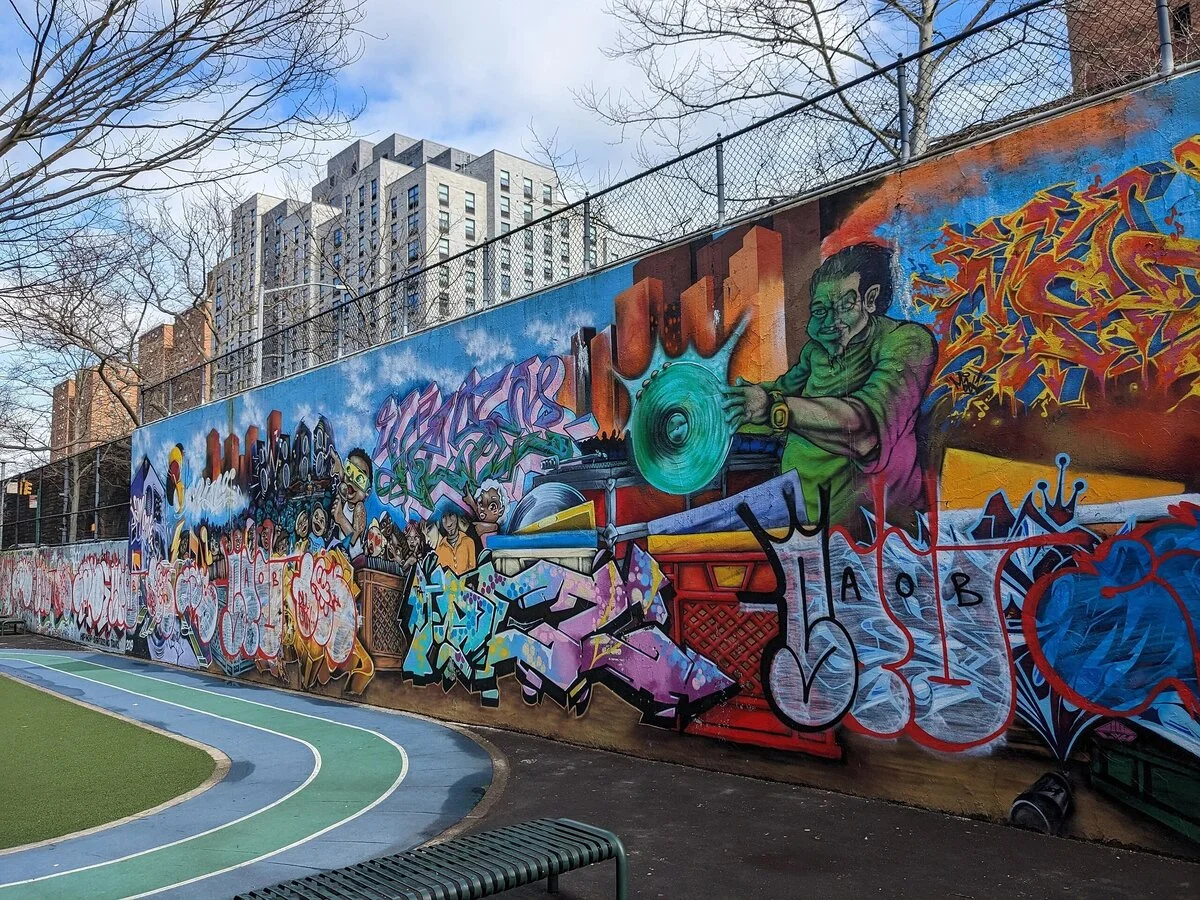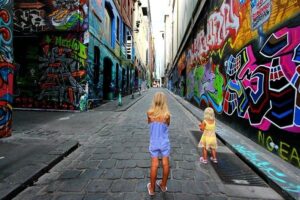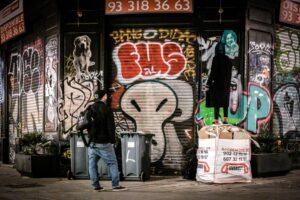From Rebellion to Recognition: A Shifting Art Form
Once a rebellious cry in the margins of urban life, graffiti has painted its way into galleries, museums, and even corporate boardrooms. What began as illicit tags scrawled on subway cars and abandoned buildings has transformed into a global phenomenon, sparking debates about art, vandalism, and cultural identity. This article dives into the culture clash surrounding street art’s journey from outlawed expression to mainstream acclaim, exploring its history, tensions, and modern impact.
The Roots of Graffiti: A Voice for the Voiceless
Born in the Streets of the ’60s and ’70s
Graffiti as we know it emerged in the late 1960s and early 1970s in cities like Philadelphia and New York. Young people, often from marginalized communities, used spray cans to tag their names or pseudonyms on public spaces, claiming visibility in a world that overlooked them. These early tags were raw, unpolished, and deeply personal—a way to say, “I exist.”
A Tool for Protest and Identity
Graffiti wasn’t just about art; it was a megaphone for social and political commentary. From Chicano murals in Los Angeles to gang-related tags marking territory, it gave voice to those excluded from mainstream discourse. Artists like Cornbread in Philadelphia and TAKI 183 in New York became legends, their tags sparking a movement that would soon intertwine with hip-hop culture.
The Culture Clash: Vandalism vs. Art
The Outlaw Label
For decades, graffiti was synonymous with vandalism. City officials and property owners saw it as a blight, a symbol of urban decay. In the 1980s, New York City’s aggressive subway cleanup campaigns aimed to erase graffiti entirely, equating it with lawlessness. Arrests were common, and artists faced fines or jail time for their work.
The Artistic Awakening
By the 1980s, a shift began. Artists like Keith Haring and Jean-Michel Basquiat took graffiti-inspired styles into galleries, blurring the line between street and fine art. Their success challenged perceptions, proving graffiti could be more than vandalism—it could be a legitimate art form with cultural weight. Yet, this mainstream embrace sparked tension among purists who feared the loss of graffiti’s rebellious soul.
The Mainstream Breakthrough
From Subway to Gallery
The early 2000s marked a turning point. Artists like Banksy and Shepard Fairey gained global fame, their works fetching millions at auction houses like Sotheby’s. Museums, such as the Museum of Contemporary Art in Los Angeles, hosted exhibitions like Art in the Streets (2011), showcasing graffiti’s evolution. Suddenly, what was once criminal was celebrated in elite art circles.
Street Art in Pop Culture
Street art’s influence spilled into fashion, advertising, and media. Brands like Supreme collaborated with graffiti artists, while movies and documentaries highlighted figures like Banksy. Social media amplified this trend, with Instagram turning vibrant murals into viral content. Street art became a backdrop for selfies, a symbol of urban cool.
The Tension of Commercialization
Selling Out or Scaling Up?
As street art gained commercial traction, a rift emerged. Some artists embraced opportunities to create murals for brands or cities, seeing it as a way to reach wider audiences. Others viewed it as “selling out,” arguing that graffiti’s essence lies in its defiance of authority. This tension mirrors a broader cultural clash: can an art form born in rebellion thrive in the mainstream without losing its edge?
Gentrification and Displacement
Street art’s rise often coincides with urban redevelopment. Neighborhoods once deemed “sketchy” become “hip” as murals attract tourists and businesses. In places like Los Angeles’ Arts District, graffiti-covered walls signal revitalization—but also gentrification. Longtime residents, including Chicano muralists, have seen their cultural symbols replaced by trendy, politically neutral street art, raising questions about who controls public spaces.
Key Players in the Street Art Movement
Pioneers Who Paved the Way
- Cornbread (Darryl McCray): Often credited as the first modern graffiti writer, his tags in 1960s Philadelphia laid the groundwork for the movement.
- Keith Haring: His bold, cartoon-like figures brought graffiti to mainstream audiences, addressing social issues like AIDS and racism.
- Jean-Michel Basquiat: A graffiti artist turned art-world star, his raw, expressive works bridged street and gallery.
Modern Icons
- Banksy: Known for anonymity and sharp social commentary, Banksy’s stencils like Balloon Girl have become cultural touchstones.
- Shepard Fairey: Creator of the iconic Obama “Hope” poster, Fairey’s work blends street art with political activism.
- Judith Baca: A Chicana muralist whose community-driven works, like The Great Wall of Los Angeles, celebrate marginalized voices.
Street Art vs. Graffiti: What’s the Difference?
Defining the Terms
While often used interchangeably, “graffiti” and “street art” have distinct connotations. Graffiti typically refers to text-based tags or throw-ups, often done without permission. Street art encompasses murals, stencils, and installations, frequently commissioned or created with artistic intent. The line blurs as both forms gain legitimacy.
A Comparison Table
| Aspect | Graffiti | Street Art |
|---|---|---|
| Primary Form | Tags, throw-ups, lettering | Murals, stencils, installations |
| Legality | Often illegal | Often commissioned or legal |
| Purpose | Self-expression, territory marking | Artistic expression, social commentary |
| Perception | Associated with vandalism | Viewed as public art |
| Examples | Subway tags, gang signs | Banksy’s stencils, Shepard Fairey’s murals |
The Pros and Cons of Graffiti’s Mainstream Rise
Pros
- Cultural Recognition: Graffiti is now celebrated as a legitimate art form, with artists gaining global acclaim.
- Urban Revitalization: Murals attract tourism and investment, transforming neglected areas into cultural hubs.
- Social Commentary: Street art provides a platform for addressing issues like inequality and racism.
- Accessibility: Unlike gallery art, street art is free and accessible to all, democratizing creativity.
Cons
- Loss of Rebellion: Mainstream acceptance risks diluting graffiti’s anti-establishment roots.
- Gentrification: Street art can signal rising property values, displacing longtime residents.
- Commercialization: Corporate collaborations may prioritize profit over authenticity.
- Legal Tensions: Unauthorized graffiti still faces crackdowns, creating a divide between “legal” and “illegal” artists.
The Global Impact of Street Art
Street Art as Urban Identity
Cities worldwide have embraced street art to brand themselves as cultural destinations. From Pittsburgh to Pretoria, murals and graffiti festivals draw crowds, boosting local economies. In Dakar, Senegal, and Seoul, South Korea, street art tours highlight vibrant walls that reflect local traditions and global influences.
A Tool for Social Change
Street art remains a powerful medium for activism. Murals addressing climate change, racial justice, and gender equality adorn walls from Mexico City to Brisbane. Artists like Judith Baca use their work to amplify marginalized voices, proving street art’s potential to spark dialogue and drive change.
Navigating the Legal Landscape
Where to Create Street Art Legally
For aspiring artists, finding legal spaces is key. Many cities offer designated walls or programs for street art:
- Miami’s Wynwood Walls: A global hub for murals, open to artists by application.
- Berlin’s East Side Gallery: A remnant of the Berlin Wall, now a legal canvas for street art.
- Local Community Programs: Cities like Los Angeles and Detroit have initiatives for commissioned murals.
Best Tools for Street Artists
- Spray Paint: Brands like Montana Gold offer vibrant, durable colors.
- Stencils and Rollers: Ideal for detailed designs or large-scale murals.
- Digital Tools: Apps like Procreate help artists sketch designs before hitting the wall.
People Also Ask (PAA)
What is the difference between graffiti and street art?
Graffiti often refers to unauthorized, text-based tags, while street art includes murals and installations, frequently commissioned. Both share roots in public expression, but street art is more widely accepted as a legitimate art form.
Is street art legal?
It depends. Unauthorized graffiti is illegal and can lead to fines or arrests. However, many cities offer legal walls or commission murals, allowing artists to create without legal risk.
How has street art impacted urban culture?
Street art has revitalized neighborhoods, attracted tourism, and provided a platform for social commentary. It bridges subcultures and mainstream society, though it can also contribute to gentrification.
Who are the most famous street artists today?
Banksy, Shepard Fairey, and ROA are among the most recognized, known for their thought-provoking works and global influence. Their art spans social commentary, political activism, and cultural reflection.
A Personal Reflection: The Walls That Speak
Growing up in a small town, I remember stumbling across a faded mural on an old warehouse—a vibrant depiction of local history painted by an unknown artist. It wasn’t polished, but it felt alive, like the wall itself was whispering stories of the community. Years later, visiting cities like Miami and Berlin, I saw how street art could transform entire neighborhoods. But I also saw the tension: a mural might beautify a street, yet signal rising rents that push out longtime residents. This duality—art as both rebellion and gentrifier—fascinates me. It’s a reminder that every spray can carries a story, and every wall is a battleground for identity.
The Future of Street Art
Balancing Authenticity and Accessibility
As street art continues to evolve, the challenge is preserving its raw, rebellious spirit while embracing its mainstream appeal. Artists must navigate a fine line between staying true to their roots and seizing opportunities in galleries or corporate collaborations. The future lies in fostering spaces where creativity thrives without compromising authenticity.
Technology’s Role
Digital platforms like Instagram and augmented reality (AR) are reshaping street art. AR apps let artists layer virtual designs over physical walls, creating interactive experiences. Meanwhile, social media amplifies their reach, turning local murals into global phenomena. Yet, this digital shift raises questions: can virtual art capture the gritty essence of a spray-painted wall?
FAQ
How did graffiti start?
Graffiti began in the late 1960s in cities like Philadelphia and New York, where youth used tags to claim space and express identity. It grew alongside hip-hop culture, evolving into a global art form.
Why is street art controversial?
Street art sparks debate because it straddles the line between vandalism and art. While some see it as a creative expression, others view unauthorized works as defacement, leading to legal and cultural clashes.
Can anyone become a street artist?
Yes, but it requires skill, creativity, and awareness of legal boundaries. Start with legal walls, practice techniques, and build a unique style to stand out in the competitive street art scene.
How do cities benefit from street art?
Cities gain cultural vibrancy, tourism, and economic boosts from street art. Murals attract visitors, revitalize neighborhoods, and foster community pride, though they can also drive gentrification.
What tools do street artists use?
Street artists use spray paint, stencils, rollers, and digital tools like Procreate for planning. Brands like Montana Gold are popular for their quality and range of colors.
Conclusion: A Canvas of Contradictions
Street art’s journey from outlawed graffiti to mainstream marvel is a tale of rebellion, recognition, and reinvention. It’s a canvas where marginalized voices meet corporate interests, where beauty clashes with bureaucracy. As cities embrace murals and galleries celebrate taggers, the culture clash persists: can street art remain a defiant cry while adorning the walls of the establishment? Only time—and the next spray can—will tell.








